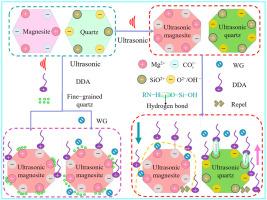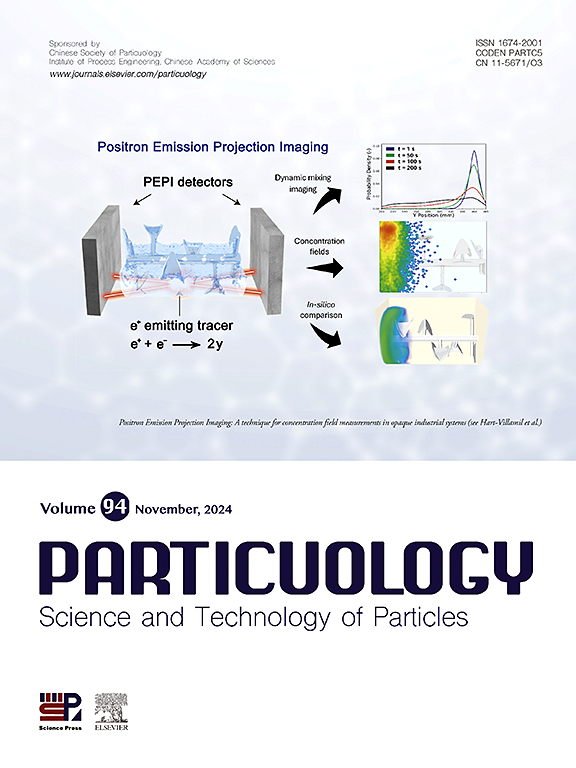Investigation of the flotation behavior and interaction characteristics of micro-fine quartz and magnesite in a dodecylamine system under ultrasonic treatment
IF 4.1
2区 材料科学
Q2 ENGINEERING, CHEMICAL
引用次数: 0
Abstract
Ultrasonic treatment, as an important surface modification method, profoundly affects the flotation behavior of minerals. This study examined the impact of ultrasonic treatment on the surface properties and flotation performance of magnesite and quartz in a dodecylamine (DDA) flotation system. Atomic force microscope detection results revealed that the surface roughness and roughness size of both magnesite and quartz increased after ultrasonic treatment. Flotation tests indicated that the recovery rates of magnesite and quartz were lower after ultrasonic treatment. At pH of 10 and DDA of 75 mg/L, ultrasonic treatment led to a 0.66%, 3.46%, and 0.33% decrease in the flotation recovery rates for three different magnesite particle sizes. Following ultrasonic processing, the flotation recovery rates for three different quartz particle sizes decreased by 8.48%, 30.76%, and 43.69%, in that order. X-ray photoelectron spectroscopy detection results showed an increased presence of characteristic Mg and Si sites on the surfaces of magnesite and quartz following ultrasonic treatment. DDA acted on the surfaces of the two minerals through electrostatic adsorption and hydrogen bonding adsorption and repelled the flotation of minerals owing to the same charge as characteristic sites, thereby reducing flotation recovery. Adsorption capacity tests and contact angle measurements demonstrated a decrease in DDA adsorption and contact angle on the surfaces of magnesite and quartz after ultrasonic treatment, explaining the reduced floatability. Extended Derjaguin–Landau–Verwey–Overbeek theoretical calculations indicated that before ultrasonic treatment, there was a repulsive energy between magnesite and fine-grained quartz particles. After ultrasonic treatment, the interaction energy between magnesite and fine quartz particles is mutual attraction.

超声波处理下十二胺体系中微细石英和菱镁矿的浮选行为及相互作用特征研究
超声波处理作为一种重要的表面改性方法,深刻影响着矿物的浮选行为。本研究考察了在十二胺(DDA)浮选系统中超声波处理对菱镁矿和石英表面性质和浮选性能的影响。原子力显微镜检测结果表明,超声波处理后,菱镁矿和石英的表面粗糙度和粗糙度尺寸都有所增加。浮选试验表明,超声波处理后菱镁矿和石英的回收率较低。在 pH 值为 10 和 DDA 值为 75 mg/L 的条件下,超声波处理导致三种不同粒度的菱镁矿的浮选回收率分别下降了 0.66%、3.46% 和 0.33%。超声波处理后,三种不同粒度的石英的浮选回收率依次降低了 8.48%、30.76% 和 43.69%。X 射线光电子能谱检测结果表明,超声波处理后,菱镁矿和石英表面的镁和硅特征位点增多。DDA 通过静电吸附和氢键吸附作用于这两种矿物的表面,由于与特征位点带相同的电荷而排斥矿物的浮选,从而降低了浮选回收率。吸附容量测试和接触角测量结果表明,经过超声波处理后,菱镁矿和石英表面的 DDA 吸附量和接触角都有所下降,这就是可浮性降低的原因。扩展的 Derjaguin-Landau-Verwey-Overbeek 理论计算表明,在超声波处理之前,菱镁矿和细粒石英颗粒之间存在斥能。超声波处理后,菱镁矿和细粒石英颗粒之间的相互作用能为相互吸引。
本文章由计算机程序翻译,如有差异,请以英文原文为准。
求助全文
约1分钟内获得全文
求助全文
来源期刊

Particuology
工程技术-材料科学:综合
CiteScore
6.70
自引率
2.90%
发文量
1730
审稿时长
32 days
期刊介绍:
The word ‘particuology’ was coined to parallel the discipline for the science and technology of particles.
Particuology is an interdisciplinary journal that publishes frontier research articles and critical reviews on the discovery, formulation and engineering of particulate materials, processes and systems. It especially welcomes contributions utilising advanced theoretical, modelling and measurement methods to enable the discovery and creation of new particulate materials, and the manufacturing of functional particulate-based products, such as sensors.
Papers are handled by Thematic Editors who oversee contributions from specific subject fields. These fields are classified into: Particle Synthesis and Modification; Particle Characterization and Measurement; Granular Systems and Bulk Solids Technology; Fluidization and Particle-Fluid Systems; Aerosols; and Applications of Particle Technology.
Key topics concerning the creation and processing of particulates include:
-Modelling and simulation of particle formation, collective behaviour of particles and systems for particle production over a broad spectrum of length scales
-Mining of experimental data for particle synthesis and surface properties to facilitate the creation of new materials and processes
-Particle design and preparation including controlled response and sensing functionalities in formation, delivery systems and biological systems, etc.
-Experimental and computational methods for visualization and analysis of particulate system.
These topics are broadly relevant to the production of materials, pharmaceuticals and food, and to the conversion of energy resources to fuels and protection of the environment.
 求助内容:
求助内容: 应助结果提醒方式:
应助结果提醒方式:


